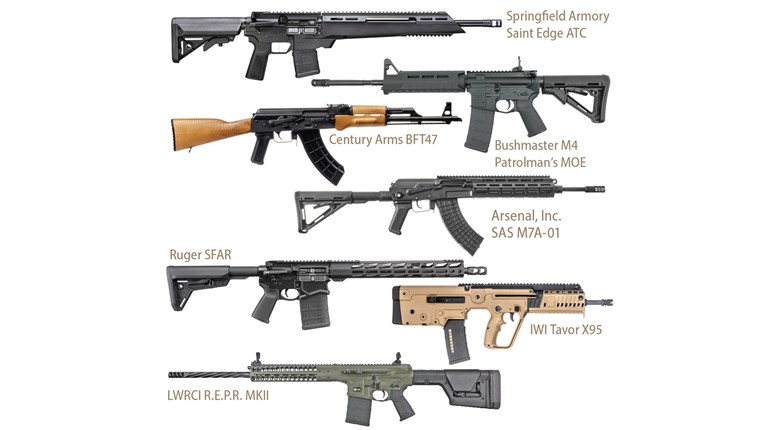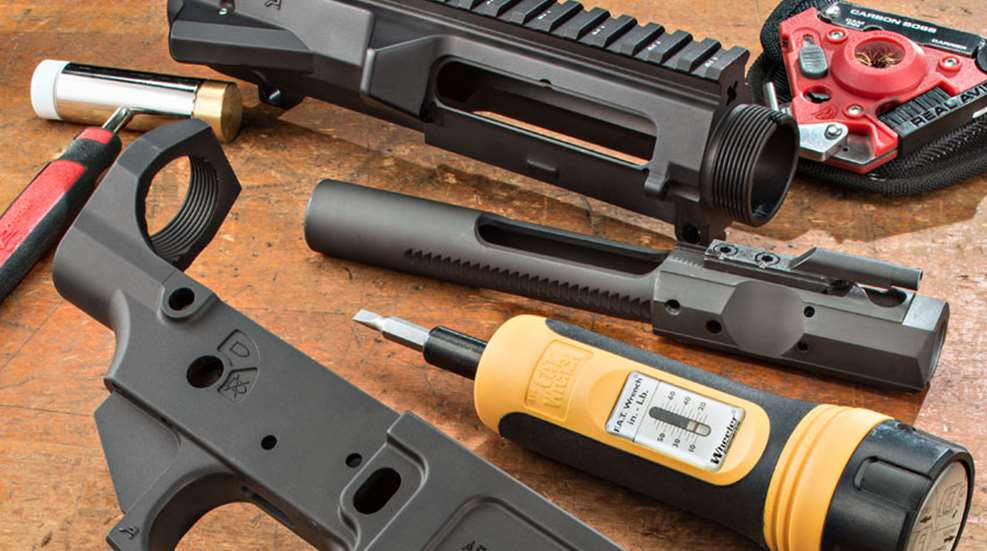
Thanks to the M16 family’s decades of U.S. military service and the AR-15’s 60 years of civilian use, navigating the world of component compatibility is not too difficult with AR-15-size firearms. Standardized core components simplify the process of mixing and matching receivers, receiver extensions/buffer tubes and freefloat fore-ends, in most cases. However, the same cannot be said for large-frame, AR-10-size platforms. This is where component compatibility can leave you in one of two conditions: confused or screaming obscenities.
Even though ArmaLite’s original AR-10 pre-dates the smaller and more-popular M16 and AR-15-style firearms, the larger rifle’s more-recent popularity in both military and civilian circles has left gun and part manufacturers to their own devices when it comes to receiver designs. The resulting mess of options created by different receiver threads, profiles, thicknesses, widths and top-rail heights has left a whole slew of gunsmiths, home builders and small manufacturers in its very frustrating wake. I fit each of those categories today, but I was first introduced to the large-frame AR when I was issued a Knight’s Armament SR25 for sniping duties in the mid-1990s. I carried numerous evolutions of the large-frame-AR platform and conducted R&D on several models over a 12-year span. Those experiences gave me a good feel for its strengths and weaknesses and exposed me to the challenges I encounter today while building them for a living.
AR-10-style rifles and upper-receiver assemblies comprise 22 percent of the work I have done over the past decade. One of the biggest lessons I have learned is which components do or do not work together. Whether you are building or shopping for an AR-10-size rifle, pistol, SBR or upper, just knowing some of the ins and outs of component compatibility can save you time and money. A few troubleshooting tips may also save you frustration when it comes time to send rounds downrange.
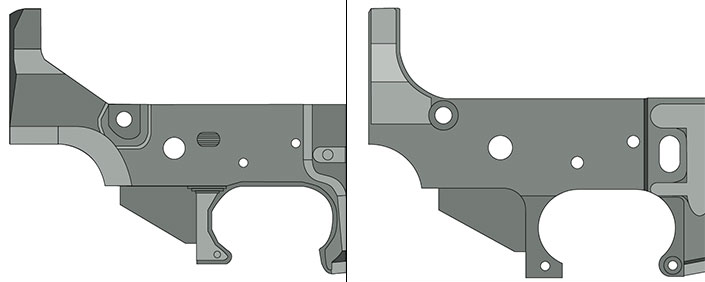
Decisions, Decisions…
The first bridge you have to cross when setting off down the large-frame AR road is to decide which receiver pattern you want (or need). The two most-common types are ArmaLite (or AR-10, which is trademarked by ArmaLite) and DPMS (or LR-308) patterns. ArmaLite-patterned receivers are most easily identified by the angled cut at the rear/bottom of the upper receiver where it mates to the lower. Some manufacturers using the ArmaLite pattern (besides ArmaLite) are Knight’s Armament, LaRue Tactical, Rock River Arms, Mega Arms and Eagle Arms. The DPMS pattern is more popular in the commercial market and therefore has more aftermarket options. This receiver style has a curved junction of the upper and lower rear receiver areas. A few examples are receivers from DPMS (Gen 1 only), CMMG, JP Enterprises, Fulton Armory, Falkor, Palmetto State Armory, and Aero Precision. Smaller receiver variations exist, too, thanks to a growing list of manufacturers producing reduced-size ARs chambered for .308 Win.-length cartridges. To the best of my knowledge, these smaller receivers are all of proprietary design and not currently available as stripped components, so my focus here will remain on large-frame ARs.
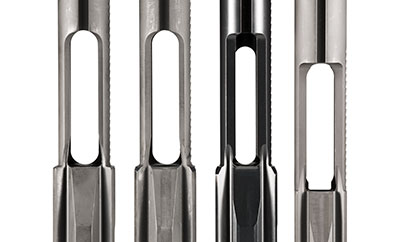
While it is possible in some cases to mate an ArmaLite-style upper to a DPMS-style lower (but not vice versa), the large gap created by different receiver geometries allows debris into the action and trigger group. This opening could be hazardous if excess gas and powder vents there, or if something like a case-head separation were to happen during firing. Keep like receiver types together, and if at all possible, use like upper and lower receiver brands to eliminate any problems with fit. Although brand A may have the same receiver design as brand B and the two may mate together securely, that is not a guarantee they will actually play well together when it is time to shoot. Making matters worse, some manufacturers use unique barrel-nut threads-per-inch (tpi) measurements, so their receivers only accept specific barrel nuts and fore-ends. Always ensure you buy a fore-end that was specifically intended for your receiver model.
Two magazine styles are most commonly encountered in big ARs: ArmaLite’s “Assault Weapons Ban” era, AR-10-pattern lower receivers or “B-Series” rifles use magazines based on the M1A/M14 design. Most other brands and models—including DPMS-pattern receivers and ArmaLite’s pre-ban or “A Series”—use modern magazines based on the original waffle-pattern AR-10 magazine. This mag is commonly referred to as “SR” or “DPMS” pattern. SR-pattern mags from Magpul, Lancer and D&H Industries are reasonably priced and work well in a wide variety of lowers. Far less common are big ARs that use FN FAL-pattern magazines; Rock River’s LAR-8 is a current example of this rare breed.
Do not mix firing pin and bolt combinations. In particular, ArmaLite AR-10 firing pins should be used with AR-10 bolts and DPMS-pattern firing pins should be used with DPMS-pattern bolts. The AR-10 firing pin’s tapered tip can become stuck forward in a DPMS pattern bolt, creating a fixed firing pin that may “slam fire” when closing on a live round, which could lead to an unintentional discharge of a round or rounds.
Once you have decided on your receiver brand and type, you will need to decide on upper-receiver rail height. The two most common heights are referred to as “hi” and “low” and differ by approximately .045 inch in height. Although the small difference in receiver height is not noticeable when you are behind the gun, this dimension matters if your fore-end has a section of rail on top. Accordingly, common freefloat fore-ends for DPMS-pattern receivers are advertised in hi and low configurations. Matching receiver and freefloat rail heights keeps iron sights on the same plane and ensures co-alignment of riflescopes and forward-mounted night-vision optics.
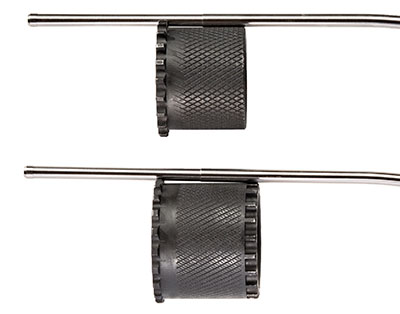
Common Ground
Some AR components may be used in both AR-15 and AR-10 receiver sizes. With a few exceptions, trigger assemblies, gas tubes, gas blocks/regulators, receiver extensions, pistol grips, buttstocks, magazine releases, selectors and rail-mounted accessories work in each case. Forward-assist buttons are, too, but some companies use a heavier spring in their AR-10-size guns. My experience has been that standard, 5.56 NATO-size forward-assist assemblies work in either size upper receiver. Most of the small springs and detent pins in lower-receiver parts kits work in both large and small ARs.
Divergence
Aside from the obvious receiver, barrel, magazine and fore-end differences, other key components are unique to larger ARs. Muzzle devices are usually threaded for 5⁄8-24 tpi, though sometimes 3⁄4-24 tpi is used instead of the small AR’s 1⁄2-28 threads. Bolt-carrier groups and charging handles are likewise sized for the larger AR and are not compatible with AR-15-size guns. Front and rear takedown pins and bolt stops are usually longer to accommodate the wider lower receivers. A few manufacturers use proprietary lower pins, so check to make sure you have the right parts. Many .308-size bolt stops are secured in the lower receiver by a threaded pin instead of the smaller AR’s roll pin. Variations in receiver wall geometry prevent a universal .308 bolt-stop design from working in all guns. While modifying some small parts is possible, you can save yourself much pain by getting all of them from the same company that built your receiver.
Several buffer lengths are used in .308-size ARs, varying by manufacturer and buffer-tube styles. Most companies use a very short carbine buffer (for collapsible stocks) or a longer rifle-length buffer, neither of which are compatible with longer 5.56 NATO buffers. An exception is the Spike’s Tactical .308 Win. AR carbine buffer tube, which uses a 5.56 NATO AR carbine buffer. The large frame AR’s rifle and carbine buffer springs are also heavier than 5.56 NATO-size springs.

Trouble Spots
Many an AR mechanic has been frustrated by troublesome large-frame guns. Some big-name manufacturers have been plagued by problems with entire fleets and use their unfortunate customers (usually U.S. or state government entities) as R&D test beds. A few custom shops simply avoid large-frame ARs like the plague. There are a few things you can do to reduce the chances of encountering common problems when building or troubleshooting your own large-frame AR.
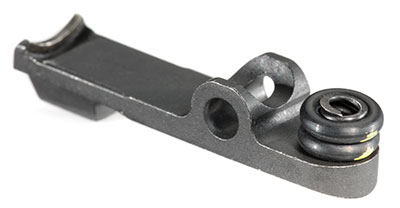
The most common cause of malfunctions I see originates in the gas system: either too much or too little gas pressure. While the problem rears its head most often in DI gas systems, I also encounter the occasional piston gun with gas issues. Mid-length DI gas systems run far better than do carbine lengths in larger-caliber chamberings. Rifle-length systems are better still, even in 16-inch barrels. I am a firm believer in the use of adjustable gas systems, be they at the gas block, on the gas tube or in the bolt carrier. Properly regulating the pressure that gets into the system is the best way to ensure all components do their jobs at the correct moment—referred to as timing—to ensure proper function. Piston guns led the way on this front for years, but many good options for adjustable DI gas blocks are available today. For situations where changing the gas block or regulator is not possible, a trial-and-error approach to changing buffer, action spring or bolt-carrier weights may help.
A large percentage of .308 Win. AR barrels I buy have undersize gas ports. The resulting low pressure can be remedied by opening the ports in very small increments. If you find yourself stumped by functional problems after applying the simpler remedies, check your extractor tension and try to lighten its spring to see if that is what is throwing off the system’s timing. Many .308 extractors are set up with too much tension by way of heavy springs and one or even two “donuts.” That slows release of spent casings to the point they do not fully eject before the bolt begins to close, causing a stoppage.
Variations exist in the length of the front, threaded portion of large AR receivers. Therefore, it is a good idea to look inside your receiver when the barrel is fully seated, specifically checking the point where the rear face of the barrel extension and feed ramps terminate at the receiver. You can get away with ramps that are forward of the shoulder inside the upper receiver, but there is very little margin for error if they extend back over that same edge, forming a lip. If you can feel that lip with your finger or see it, the ramps will probably need to be re-shaped. That job is best left to an AR-smith. Likewise, a barrel extension seated so far forward in the upper that it causes feeding problems will need professional work.

Direct-impingement gas tubes may be intended for all AR receiver sizes, but their geometry is designed around the smaller AR’s barrel nut. Because .308 Win.-size ARs use a larger-diameter barrel nut, their gas tubes are forced into a different angle than they were bent for. Too much of an angle change will cause binding of the gas tube’s end inside the bolt carrier’s key. Minor binding can affect accuracy, but major binding will cause malfunctions. A somewhat simple method to fix this problem is to carefully bend the end of the gas tube that protrudes inside the upper receiver—usually up or down—until the binding is eliminated. Make very minor corrections and take care in all cases not to kink or gouge the gas tube. ArmaLite rifles use unique gas-tube lengths, so their barrels need to be mated to ArmaLite gas tubes in order to ensure gas ports meet up properly.
Full-length operating rods and short-stroke or “pusher rods” used on non-DI operating systems sometimes need tweaks, too. Occasionally, they will get bent just enough to bind somewhere along their route of travel, usually where they pass through a bushing. A bent rod is best replaced.
A final trouble spot relates to carbine-length buffer tubes. When the bolt carrier is at its rear-most point during the cycle of operation, its rails should not impact the lower-receiver bridge at any point where the buffer tube threads in. Unfortunately, many .308 Win. ARs are built without any regard to preventing this contact, which gouges the lower receiver as the bolt carrier’s rails hammer into it with every shot. Forged and billet lowers are tough, but their aluminum was not designed to withstand being repeatedly pummeled by hardened steel. If you see gouges or impressions from the carrier in this area, the problem needs to be fixed. I have only seen this problem in large-frame ARs, with both mil-spec and commercial-diameter carbine buffer tubes. In many cases, the bolt carrier, buffer and spring go farther back than they should during cycling and the condition worsens as the buffer’s soft tip wears over time.
One fix is to shorten the front edge of the buffer tube by one turn’s worth of threads, reducing the distance the buffer and carrier can travel rearward. A slightly longer buffer will also work, but not one so long that it prevents the bolt from locking back when the bolt stop is activated. KAK Industries’ double ejector, nitrided .308 bolt-carrier group has gently angled rail ends that virtually eliminate any chance of impact with the lower receiver. A few lower-receiver makers machine-in recesses to prevent this carrier/receiver contact in the first place. If your lower has been beat up by the carrier, after correcting the cause you can smooth out the gouges to get rid of the rough edges and color it with a little permanent marker—invisible when the rifle is assembled—to help watch for any new contact with the bolt carrier.
These problems are not the only ones encountered with large-frame ARs, but they are the ones I see most often. The good news is that once properly configured, the big guns work very well. I have staked my life on them many times, and would not hesitate to do so again if the need arose.














